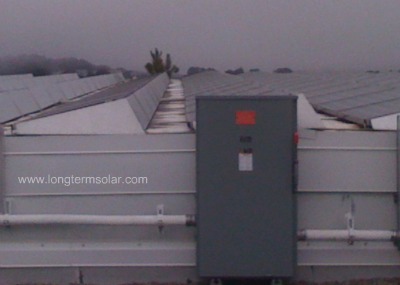Today, let’s all try to figure out how much electricity is being produced from a large photovoltaic solar system. This particular system is located in an area where there are a few different factors taking place. First, you can see from the picture that the sunlight is not clear, and that there is quite a bit of fog or clouds in-between the sun and the PV. Also, you can notice that all of the panels are mounted at an angle towards the sun.
In order to figure out how many kilo watt hours of electricity are produced by this system, we need to understand some of the variables. In other words, we need to know the variables that are part of the electricity output equation.
The information we need to solve the math equation relating to solar output are:
- the number of solar panels
- the wattage of the solar panels
- Angle towards the sun that is ideal for the solar panels to rest (latitude minus 15 degrees)
- The amount of average sunlight hours per day for this particular region
- The percent of energy loss from this particular system
- The amount of shading that occurs each day while the sun is shining
For this equation: The information above is the following:
- 396 solar panels
- 195 watts per solar panel
- The solar panels are mounted at the best angle which is 23 degrees (latitude of 38, minus 15 degrees, equals 23 degrees)
- The average sunlight hours per day figure is exactly 5 hours of sun per day and was found on the sunlight hours page
- This system loses 14% of it’s energy from both the inverter and other energy loss areas
- The shading is roughly 15% according to the Solarpathfinder analysis which calculated shading amounts
Calculating the Electricity from this Solar System:
First: Calculate the total number of watts you have from the solar panels:
396 * 195 = 77,220 watts
Second: Since the solar panels are in-fact mounted at a great angle towards the sun (south to south west) at 23 degrees, which is ideal in this particular location. As a general rule, your degrees of latitude minus 15 degrees is almost always the ideal angle to mount your solar panels. (For this particular equation, direction of the panels and angle of the panels is not going to detract from optimal performance.)
Third: OK, now we need to keep the equation moving forward by determining how many kwh (kilo watt hours) this system is going to produce. We can do that by multiplying the larger watt figure of the system which was 77,220 watts, to make this easier, we will turn that into 77.22 kW for a system size. So, take the 77.20 kWh * 5 hours per day and that will give: 386.1 kwh/day.
Fourth: We need to determine how much energy is going to be lost, and the first thing that we know is we have shade in this location. The 15% shading figure will directly impact the energy output in a negative way. And this is how it’s calculated:
386.1 kwh * 15% shade = 58 kwh each day lost due to shade
Also, we have a 14% energy loss in the conversion from DC (direct current) to AC (alternating current). So, add in this next part of the energy loss:
386.1 kwh – 58 kwh= 328.1 kwh produced in DC.
328.1 * 14% = 46 kwh lost in the energy conversion
So after everything is completed, the Solar Energy output of this solar system is going to be:
282.1 kwh each day
If you have any questions, please leave a comment below and I will respond to you right away.



